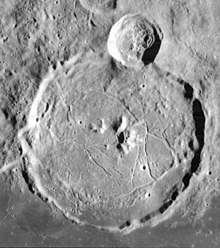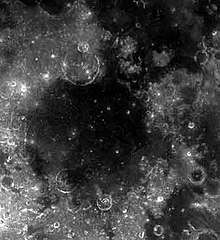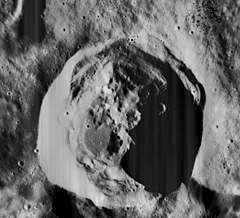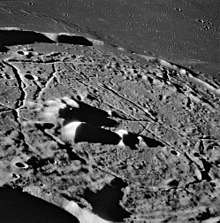Gassendi (crater)
Gassendi is a large lunar impact crater feature located at the northern edge of Mare Humorum. It was named after French astronomer Pierre Gassendi.[1] The formation has been inundated by lava during the formation of the mare, so only the rim and the multiple central peaks remain above the surface. The outer rim is worn and eroded, although it retains a generally circular form. A smaller crater – Gassendi A – intrudes into the northern rim, and joins a rough uplift at the northwest part of the floor. The crater pair bear a curious resemblance to a diamond ring.
.png) | |
| Coordinates | 17.55°S 39.96°W |
|---|---|
| Diameter | 110 km |
| Depth | 1.9 km |
| Colongitude | 40° at sunrise |
| Eponym | Pierre Gassendi |

In the southern part of the crater floor is a semi-circular ridge-like formation that is concentric with the outer rim. It is in the southern part where the rim dips down to its lowest portion, and a gap appears at the most southern point. The rim varies in height from as little as 200 meters to as high as 2.5 kilometers above the surface. The floor has numerous hummocks and rough spots. There is also a system of rilles that criss-crosses the floor, named the Rimae Gassendi.
The fresh crater Gassendi A is adjacent to Gassendi to the north. Due to its ray system, Gassendi A is mapped as part of the Copernican System.[2]On some older maps the crater Gassendi A was called Clarkson, after the British amateur astronomer and selenographer Roland L. T. Clarkson, but this name is not officially recognized by the IAU and the name has been removed.
Gassendi was considered for a possible landing site during the Apollo program, but was never selected. However, it was imaged at high resolution by Lunar Orbiter 5, for this reason. It was also heavily photographed by Apollo 16.

Satellite craters
By convention these features are identified on lunar maps by placing the letter on the side of the crater midpoint that is closest to Gassendi.
| Gassendi | Coordinates | Diameter, km |
|---|---|---|
| A | 15.55°S 39.80°W | 32 |
| B | 14.66°S 40.64°W | 25 |
| E | 18.45°S 43.63°W | 7 |
| F | 15.03°S 45.02°W | 8 |
| G | 16.75°S 44.67°W | 7 |
| J | 21.62°S 37.10°W | 9 |
| K | 18.78°S 43.74°W | 6 |
| L | 20.39°S 41.79°W | 5 |
| M | 18.61°S 39.15°W | 3 |
| N | 18.07°S 39.32°W | 4 |
| O | 21.96°S 35.13°W | 10 |
| P | 17.29°S 40.75°W | 2 |
| R | 21.94°S 37.85°W | 4 |
| T | 19.05°S 35.44°W | 10 |
| W | 17.66°S 43.73°W | 6 |
| Y | 20.91°S 38.51°W | 5 |

References
- "Gassendi (crater)". Gazetteer of Planetary Nomenclature. USGS Astrogeology Research Program.
- The geologic history of the Moon, 1987, Wilhelms, Don E.; with sections by McCauley, John F.; Trask, Newell J. USGS Professional Paper: 1348. Plate 11: Copernican System (online)
- Andersson, L. E.; Whitaker, E. A. (1982). NASA Catalogue of Lunar Nomenclature. NASA RP-1097.CS1 maint: ref=harv (link)
- Bussey, B.; Spudis, P. (2004). The Clementine Atlas of the Moon. New York: Cambridge University Press. ISBN 978-0-521-81528-4.CS1 maint: ref=harv (link)
- Cocks, Elijah E.; Cocks, Josiah C. (1995). Who's Who on the Moon: A Biographical Dictionary of Lunar Nomenclature. Tudor Publishers. ISBN 978-0-936389-27-1.CS1 maint: ref=harv (link)
- McDowell, Jonathan (July 15, 2007). "Lunar Nomenclature". Jonathan's Space Report. Retrieved 2007-10-24.CS1 maint: ref=harv (link)
- Menzel, D. H.; Minnaert, M.; Levin, B.; Dollfus, A.; Bell, B. (1971). "Report on Lunar Nomenclature by the Working Group of Commission 17 of the IAU". Space Science Reviews. 12 (2): 136–186. Bibcode:1971SSRv...12..136M. doi:10.1007/BF00171763.CS1 maint: ref=harv (link)
- Moore, Patrick (2001). On the Moon. Sterling Publishing Co. ISBN 978-0-304-35469-6.CS1 maint: ref=harv (link)
- Price, Fred W. (1988). The Moon Observer's Handbook. Cambridge University Press. ISBN 978-0-521-33500-3.CS1 maint: ref=harv (link)
- Rükl, Antonín (1990). Atlas of the Moon. Kalmbach Books. ISBN 978-0-913135-17-4.CS1 maint: ref=harv (link)
- Webb, Rev. T. W. (1962). Celestial Objects for Common Telescopes (6th revised ed.). Dover. ISBN 978-0-486-20917-3.CS1 maint: ref=harv (link)
- Whitaker, Ewen A. (2003). Mapping and Naming the Moon. Cambridge University Press. ISBN 978-0-521-54414-6.CS1 maint: ref=harv (link)
- Wlasuk, Peter T. (2000). Observing the Moon. Springer. ISBN 978-1-85233-193-1.CS1 maint: ref=harv (link)
External links

- Gassendi's Fractures, LROC
- Wood, Chuck (2006-07-12). "Inside Gassendi". Lunar Photo of the Day. Retrieved 2015-11-08.
- NASA Astronomy Picture of the Day: Circle 'round the Moon (13 February 2009)
- Wood, Chuck (April 12, 2007). "Ring the Bell II". Lunar Photo of the Day. Retrieved 2017-01-29.
- Wood, Chuck (December 22, 2007). "Unnecessary Mystery". Lunar Photo of the Day. Retrieved 2015-11-08.
- Lunar Orbiter 5 image (177) of southern Gassendi crater
- Lunar Orbiter 5 image (178) of central Gassendi crater
- Lunar Orbiter 5 image (179) of northern Gassendi crater and Gassendi A
